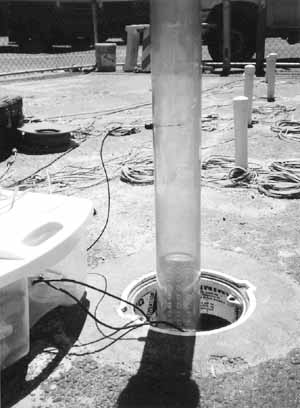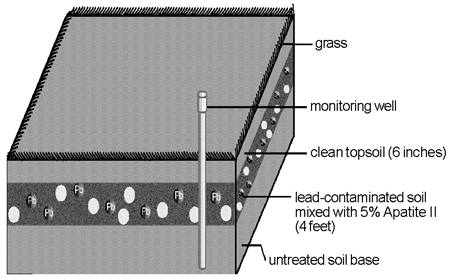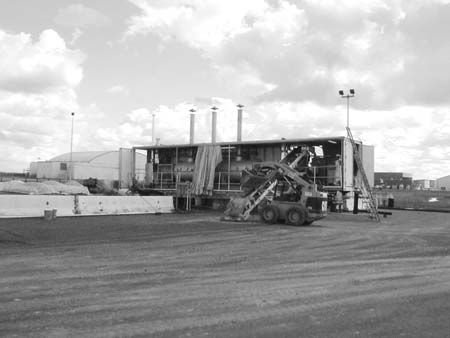|
March 2002 Passive Bioventing Demonstration Conducted by DODThrough a series of field pilot tests and a recent demonstration at Castle Airport (formerly Castle Air Force Base) near Merced, CA, the U.S. Department of Defense (DOD) is evaluating the use of natural passive bioventing to remediate unsaturated soils contaminated with petroleum hydrocarbons. Passive bioventing frequently has been demonstrated as cost-effective at sites lacking the electricity needed to run electric blowers for conventional bioventing. Most of these demonstrations, however, were conducted in arid regions with deep unsaturated zones (greater than 100 feet), high permeability, and low moisture content. The Castle Airport field demonstration, which was sponsored by DOD�s Environmental Security Technology Certification Program, indicated the technology can be used successfully in a setting with higher soil moisture and a shallower unsaturated zone. Passive bioventing utilizes the difference between gas pressure in unsaturated soil and in the atmosphere to move air into or out of vent wells. This technology can promote the extraction of any volatile contaminant from unsaturated soil by using the natural movement of soil gas out of vent wells. It is used most often to enhance soil aeration and resultant aerobic biodegradation of organic contaminants in unsaturated soil. Once air moves into a soil profile, flow is delayed and dampened by a natural resistance of the soil to airflow. Research has shown that higher rates of airflow into passive bioventing wells occur in deep soil profiles with high air permeability, such as a thick sand zone above the water table. The presence of low permeability layers above a zone with high air permeability is expected to provide comparable airflow into shallower unsaturated sandy soils. Such low permeability layers could be silt and clay strata or manufactured surface layers such as asphalt. Tests also have shown that increased soil moisture will decrease the air permeability of the soil. The Castle Airport demonstration took place between April and October 1998 in an area comprising three moderate- to high-permeability zones of fine- to medium-grain sand with minor silt and gravel deposits. Seasonal precipitation and irrigation pumping in this area routinely vary ground-water depth, which ranges from 10 to more than 70 feet below ground surface (bgs). At the time of the demonstration, a ground-water depth of 60 feet and soil moisture content of 5.8 percent (by weight) were measured. Analysis of soil and soil vapor samples indicated petroleum contaminant concentrations as high as 28,000 mg/kg in the gasoline range and 4,400 mg/kg in the JP-4 jet fuel range. Soil gas contaminant concentrations reached 54,000 parts per million by volume, with a virtual absence of oxygen gas due to natural fuel biodegradation. The demonstration used one 4-inch diameter vent well with three 10 foot-long screened and bentonite-plugged intervals covering a depth range of 25-65 feet bgs. The vent well was equipped with a one-way, passive valve to increase the potential radius of influence (Figure 1). Eight vapor-monitoring points (VMPs) with multi-depth sensors were installed in two transects extending outward from the vent well at radial distances of 4, 8, 12, and 16 feet. Additional VMPs were installed at greater distances from the vent well in order to delineate larger radii of influence or to serve as background stations in uncontaminated areas.
At ten-minute intervals, a continuous data logger at each VMP recorded the ambient temperature, ground-water elevation, barometric pressure, and rates of total and screened-interval gas flow into the vent well. In addition, subsurface differential pressures and oxygen concentrations were recorded in the same frequency at each screened interval of the VMPs. Demonstration tests indicated that the average daily volume of air entering the bioventing well was 3,400 cubic feet, with peak flow rates ranging from 5 to 15 cubic feet per minute. These rates are comparable to or greater than those encountered in passive bioventing applications at arid sites with unsaturated zones over 100 feet deep. Tests indicated that the one-way valve increased the vent well�s radius of influence significantly by preventing the backward flow of oxygenated air from the well during daily periods of low atmospheric pressure. Results also showed that the radius of influence expanded during longer operation periods. For example, a 5-percent oxygen concentration in the soil gas (the level commonly required to sustain aerobic microbial metabolism) was detected at a distance of 16 feet after 16 days of testing and as far as 42 feet after 52 days. Researchers found that the low-permeability silt and clay layers above and below each vented zone, and a ground cover consisting primarily of asphalt, aided in driving the air pressure gradient through the vent well system. Significant airflow rates were encountered even in the shallowest (25-35 feet) screened interval of the well. The performance of this technology was compared to that of conventional bioventing with electric blowers, which had been selected for soil remediation and previously tested at this site under the same geological and hydrological conditions. Airflow rates of the passive system generally were 80-90 percent lower than those obtained through the conventional system. Operation of the passive system over an extended time period is expected to compensate for this rate difference. In addition, twice the number of vent wells were installed in the passive system to address the lower radius of influence commonly associated with shallow wells. The costs for passive bioventing were very competitive with those of the conventional system. Higher costs for the installation of additional vent wells in passive bioventing were balanced by the system�s low operation and maintenance costs. A total project cost of $300,000 was estimated for each technology, with a unit cost ranging from $1.90 to $2.10 per cubic yard of contaminated soil. At a site lacking access to electricity, however, DOD estimates that passive bioventing could save approximately $100,000, which otherwise would be spent on the installation of additional power lines or generators. These studies show that passive bioventing is cost-effective for promoting biodegradation of petroleum-contaminated sandy soils at depths of less than 50 feet when covered by low-permeability layers. DOD anticipates additional demonstrations and field tests during 2002 in eastern regions of the U.S. with higher levels of soil moisture. For additional information, contact Sherrie Larson (Naval Facilities Engineering Service Center) at 805-982-4826 or larsonsl@nfesc.navy.mil. Phosphate-Induced Metal Stabilization Used for Lead-Contaminated SoilUnder the Environmental Security Technology Certification Program, the U.S. Department of Defense (DOD) is holding its first field-scale demonstration of phosphate-induced metal stabilization (PIMS) in soil. The demonstration is evaluating the use of PIMS with Apatite II™ for remediation of lead-contaminated soil at the Camp Stanley Storage Activity (CSSA) subinstallation of the Red River Army Depot in Boerne, TX. In addition to validating the technology�s effectiveness, the demonstration will determine its field costs, assess its regulatory acceptance, and provide an acceptable alternative to offsite disposal. Preliminary results show lead stabilization of all 3,000 cubic yards of soil treated. Through simple soil mixing, PIMS stabilizes metals using a natural and benign phosphate additive (apatite) that chemically binds soluble metals into stable, insoluble minerals. Apatite II holds up to 20 percent of its weight in lead, uranium, and other metals. Once the metals are removed by precipitation from the soil solution and sequestered in the new apatite phase (within minutes), the metals are considered stable, i.e., with significantly reduced mobility and bioavailability for geologically long time periods. DOD selected onsite stabilization at the CSSA due to the large volume of contaminated soil involved, insufficient space for contaminated soil disposal, the technology�s ability to return the soil to viable future use, and implementation costs that were lower than other technologies considered. Evaluation of PIMS indicated that it would produce a stable end-product mineral for the metal (pyromorphite [Ksp ~ 10-80]) and could be implemented through existing technology. It also was determined that PIMS would have little impact on soil properties and would not affect nearby wetlands bioremediation activities. The primary mission of CSSA is the receipt, storage, issue, and maintenance of ordnance. Until 1986, an open burn/open detonation area operated at a location now known as solid waste management unit B-20 (SWMU B-20). Site investigations at SWMU B-20 indicated that particulate lead occurred in localized soil zones at concentrations ranging from 200 to 40,000 parts per million (ppm) and averaging 3,100 ppm. SWMU B-20 occupies approximately 35 acres. It is underlain by three soil types with an average density of 104 pounds per cubic foot and an average permeability of 3.3 x�10-4 inches per second. The area receives approximately 28 inches of precipitation annually. To measure leachate and comply with regulatory requirements, CSSA conducted a trial application of the technology at SWMU B-20 prior to full-scale operation. The treatment area was underlain by a landfill-type leachate collection system with a 2-inch layer of Apatite II to control the lower boundary condition. Using a standard backhoe, approximately 35 tons of Apatite II was mixed into 500 cubic yards of lead-contaminated soil to achieve a 5-percent (by weight) mixture of Apatite II. (Feasibility study results had indicated that larger amounts of Apatite II would not increase performance but would increase costs significantly, while lower amounts were difficult to mix evenly into the soil.) The trial mixture then was covered with coarse gravel to encourage infiltration and recharge, to provide a walking surface for workers performing periodic maintenance of the system, and to prevent vegetation growth. Over the following month, the treatment area was irrigated heavily at a rate equivalent to its annual precipitation. Analysis of the system leachate indicated dissolved lead concentrations below detection limits (3 parts per billion). Based on the trial results, similar methods were employed to remediate the remaining 2,500 cubic yards of lead-contaminated soil at SWMU B-20. Contaminated, upper layers of soil were collected from the entire unit and placed in onsite piles that were mixed with Apatite II (Figure 2). The mixtures were spread into a single 4-foot layer across approximately one acre, and covered with 6 inches of clean topsoil that was vegetated through grass seeding. Due to the continuous nature of the PIMS process, the site will be monitored over the next two years to assess lead mobility, bioavailability, and leaching behavior. As a result of this treatment, the State of Texas Natural Resources Conservation Commission now classifies the remediated soil at SWMU B-20 as a class II non-hazardous material. CSSA estimates a total cost of $38 per treated ton of soil to employ PIMS at this site, while offsite disposal would have cost approximately $105 per ton.
This technology was deployed in 2001 at other federal and commercial sites to remove metals in both soils and ground water. Examples include the Los Alamos National Laboratory, NM, for remediation of depleted uranium-contaminated soil, and the Success Mine, ID, for removal of zinc, lead, and cadmium from tailings-contaminated ground water. For more information, contact Dr. Judith Wright (PIMS NW, Inc.) at 505-670-5809 or judith@pimsnw.com, or Dr. Andrea Leeson (DOD) at 703-696-2118 or andrea.leeson@osd.mil. Contact Ken Rice (Parsons) at 512-719-6050 or Ken.R.Rice@parsons.com for detailed information on the Camp Stanley demonstration. Details on other PIMS applications and technology comparisons are available from Dr. James Conca (Los Alamos National Laboratory) at 505-699-0468 or jconca@lanl.gov.
Thermal Desorption Removes Range of OrganicsAs part of the National Environmental Technology Test Sites (NETTS) Program, the U.S. Air Force Base Conversion Agency (AFBCA) completed a pilot-scale demonstration of ex situ thermal desorption technology at the former McClellan Air Force Base (AFB) near Sacramento, CA. Soils from three sites at the base were treated to remove a wide range of nonvolatile and semivolatile organic compounds (SVOCs), including polycyclic aromatic hydrocarbons (PAHs), petroleum hydrocarbons, polychlorinated biphenyls (PCBs), dioxins/furans, and pesticides. The range of contaminants, together with low target cleanup goals, made this demonstration a more stringent test of the technology than prior applications. Based on the demonstration results, the AFBCA is considering full-scale implementation of thermal treatment as a remedial option for several hundred thousand tons of contaminated soil. McClellan AFB was closed in 2001 after 65 years of operations involving the use, storage, and disposal of hazardous materials such as industrial solvents, caustic cleaners, electroplating chemicals, heavy metals, low-level radioactive wastes, fuels, and oils. Site investigations indicated contaminants in areas comprising landfills, waste disposal pits, and spill sites located across the base. For the contaminants of concern, concentrations encountered during the demonstration ranged from non-detect to a maximum of 5.5 mg/kg for SVOCs (pentachlorophenol), 0.35 mg/kg for PAHs (benzo(a)pyrene), 900 mg/kg for petroleum hydrocarbons (motor oil), 58 mg/kg for PCBs (Arochlor 1260), 40 pg/g for dioxins/furans (2,3,7,8-TCDD equivalents), and 0.09 mg/kg for pesticides (4,4'-DDD). Soils in this area are primarily unconsolidated sediments with moisture content of 10-14 percent. Low-temperature (650°F-1,000°F) thermal desorption relies on heating of the contaminated soil to temperatures at which organic compounds will be liberated through volatilization, leaving behind the toxic inorganic compounds. Desorbed organic compounds are recovered from the carrier gas stream using scrubbers, condensers, and filters. Soils to be treated at the McClellan demonstration site were excavated, screened to remove oversized material, and stockpiled on a treatment pad. After processing through the thermal desorption unit, treated soils were returned to the sites of origin. The demonstration equipment used at McClellan AFB included an indirectly heated rotary dryer inside a natural gas-fired furnace, a screw feed assembly, an indirect fuel firing system, and a gas handling unit to supply and capture nitrogen carrier gas and to condense the contaminants. Equipment was mounted on two portable trailers located on the base�s existing soil treatment pad (Figure 3). Although rates varied during testing, the pilot operation unit was limited to a maximum soil feeding rate of 1,800 pounds per hour and a maximum treatment temperature of 1,000°F.
Contaminated soils from three different sites were treated during the demonstration. Five days of processing were performed for each site in two phases. In the first phase, soils were treated at 100-degree increments between 700°F and 1,000°F over two days to determine the minimum temperature required for effective treatment. In the second phase, soil was treated at a temperature of 1,000°F over three days to determine the maximum efficiency of the system. A total of 69 tons of contaminated soil was processed during the 22-day demonstration. Results indicated that, with the system operating at its maximum treatment temperature, concentrations of all organic contaminants of concern were reduced to nondetectable levels with the exception of dioxins/furans that were reduced to target cleanup goals. PAHs, SVOCs, and pesticides were removed at temperatures as low as 700°F, while nearly complete removal of petroleum hydrocarbons could be achieved at temperatures exceeding 800°F. Due to the difficulty in desorbing residual dioxins, treatment of soils containing PCBs and dioxins required temperatures of 1,000°F to achieve remediation goals. The AFBCA estimates a cost of $59-$83 per ton of soil (exclusive of excavation and backfill costs) for full-scale thermal treatment using commercially available systems. System throughputs are projected to range from 26-46 tons of soil per hour. Other factors found to impact thermal treatment include the need for an appropriate 5-acre treatment pad for process operation and soil staging, and for adequate water, gas, and electric utility connections. Demonstration results also indicate that treatment of soils with a moisture content greater than 20 percent would involve much higher fuel requirements and lower throughputs. To accommodate soil with a higher moisture content more consistently, full-scale implementation of this technology at McClellan AFB would include a thermal unit with a maximum furnace temperature of 1,400°F. In addition, the system would employ a larger, 2-inch conveyor screen mesh to ensure more consistent feeding rates, and would incorporate a treatment system for the scrubber blowdown to minimize residual contaminant. Also under the NETTS Program, McClellan AFB researchers will conclude a field-scale soil washing demonstration early this spring, and have begun planning additional demonstrations on soil vapor extraction optimization and remedial process optimization. For more information, contact Al Calise (AFBCA) at 916-643-0830 x. 221, or e-mail acalise@afbda1.hq.af.mil.
|
||
|










